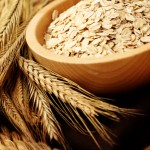 A new study conducted by researchers at Wake Forest Baptist Medical Center has found that eating more soluble fiber and fitting in moderate exercise decreases the amount of visceral fat – the dangerous fat found deep in the belly around vital organs. The key finding was that for every increase of 10 grams of soluble fiber consumed daily, visceral fat (in and around the abdominal organs) was reduced by 3.7 percent over five years. Also, moderate exercise performed for at least 30 minutes, 2 to 4 times per week, resulted in a 7.4 percent drop in the accumulation of visceral fat.
A new study conducted by researchers at Wake Forest Baptist Medical Center has found that eating more soluble fiber and fitting in moderate exercise decreases the amount of visceral fat – the dangerous fat found deep in the belly around vital organs. The key finding was that for every increase of 10 grams of soluble fiber consumed daily, visceral fat (in and around the abdominal organs) was reduced by 3.7 percent over five years. Also, moderate exercise performed for at least 30 minutes, 2 to 4 times per week, resulted in a 7.4 percent drop in the accumulation of visceral fat.
The study, published in the June 16 online issue of the journal Obesity, consisted of 1114 African Americans and Hispanic Americans, because they are racial groups at a higher risk for accumulating visceral fat. The participants were evaluated through a physical exam, a questionnaire on lifestyle issues, and a CT scan to measure how much subcutaneous fat (just beneath the skin) and visceral fat they had. The same process was completed five years later. This study is unique because it looks at the relationship between fiber and specific fat deposits, which had not yet been studied. It provides information on the role that soluble fiber plays in weight management by decreasing abdominal fat deposits.
We spoke with Dr. John Touliatos, expert bariatric surgeon at the Advanced Surgical Weight Loss Center in Birmingham, Alabama, about the study. He told us that it has long been known that visceral fat, has a higher association with metabolic syndrome. He explained that “metabolic syndrome is a compilation of diseases that include diabetes, hypertension, sleep apnea and high cholesterol, though the mechanism for this association is not fully understood.”
Dr. Touliatos said that there is a visual clue to predict which individuals may have more of the dangerous visceral fat. “While special imaging study may be the only way to accurately measure this fat for research purposes, body habitus – or shape – is a good predictor for those at risk”, he said. “We have typically referred to the ‘apple’ vs the ‘pear’ with the apple body shape being more common in males with the bulk of their obesity above the waist, and the pear found more commonly in women with their obesity in the hips and thighs,” said Touliatos.
Dr. Touliatos concluded “this study is nice in that it shows the central obesity can be targeted with dietary manipulations and exercise. This research adds another tool in our armamentarium in the battle against visceral fat, which from a standpoint of overall health, is the target of our therapies.”
Sources of soluble fiber include beans, oats, peas, apples, carrots, barley and psyllium.






Weight Loss Studies & Clinical